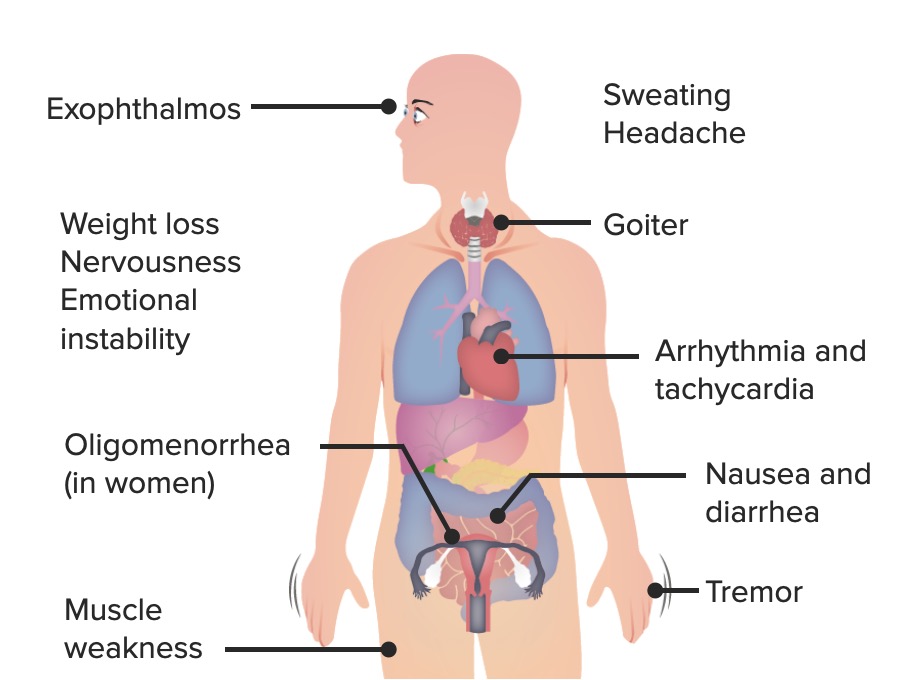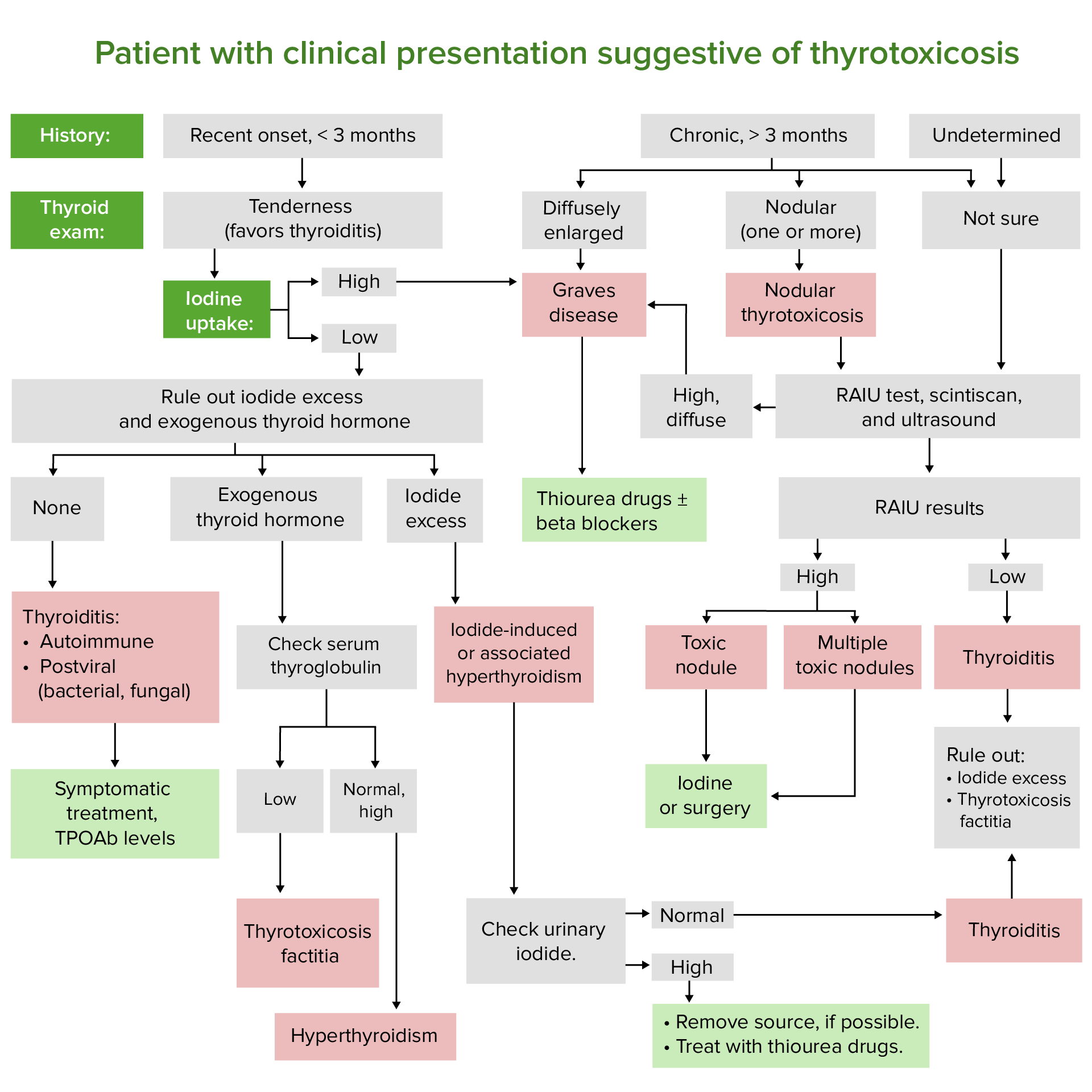Playlist
Show Playlist
Hide Playlist
Hyperthyroidism and Hypothyroidism: Signs and Symptoms
-
Slides Thyroid and Reproduction.pdf
-
Download Lecture Overview
00:00 Let's now discuss thyroid disorders and reproduction. This is a longer lecture so if you want to take a break, pause me now and go get a snack. If not, let's begin. Let's review the embryology of the thyroid gland. So the thyroid originates from the mesoderm and actually causes an outpouching from there. It then descends anterior to the trachea and bifurcates into the 2 lobes that you see in a baby or an adult. The fetal thyroid gland and pituitary thyroid axis become functional late in the 3rd trimester but by 9 to 10 weeks you can see some T4 synthesis in the baby. However, if the thyroid does not develop, you can actually have growth failure, impaired neonatal and childhood development, and mental retardation. This is called cretinism. This comes from the French word cretin. Because they were so mentally impaired, they were angelic and did nothing wrong. This can happen before the onset of fetal thyroid production because the only source of thyroid hormone is the mother. So if the mother is somehow compromised, the ensuing fetus or child will be compromised as well. Maternal hypothyroidism or low functioning thyroid can lead to this form of congenital cretinism. Let's now review hypothyroidism and hyperthyroidism. When I was a student I used to get confused between these 2 all the time but this is how you can remember it. Hyperthyroidism is like drinking 6 cups of coffee in the morning. You're jittery, you're on edge, you're anxious, you're nervous, your heart rate is beating versus hypothyroidism is like you never ever drink coffee and you're tired, you're slowed, you're not on the normal mental axis that you should be on. Let's now review the signs and symptoms of hyperthyroidism. Remember, this is the patient who is jittery after drinking so much coffee, right. But in this case, it's not coffee, it's the thyroid. So their hair loss can be actually significant. They can actually have hair on their pillow when they awaken in the morning or if they're brushing or combing their hair they may see excessive hair loss after doing so. They can also have some emotional issues. They can have lability, anxiety, fatigue, sometimes you can see they can be very short with people even though that's not their normal character. They also have some heat intolerance which means they can't really take it when it's very hot outside so they're always sweating. They can also have some muscle wasting or weakness. They can also have eye symptomatology and this is very classic with Grave's disease. They kind of have bag eyes or big eyes. They can also have diaphoresis, remember, because they have heat intolerance, they have warm skin and they're always sweating. 03:01 So remember these patients can also have a goiter which is an enlarged thyroid and due to the increased vascularity they may have or may not have a bree, which is a sound from increased blood flow. They may also become dysphagic which means it's hard for them to swallow because the thyroid is so large. These patients can often have tachycardia which actually presents as palpitations or racing heart. They sometimes can have cardiac failure and arrhythmia which of course is life threatening and often fatal. Normocytic anemia is common in these patients. They can have mild neutropenia which means decreased white blood cells, hypercalcemia which means high blood calcium, or hypomagnesemia which is low magnesium in the blood. They may have elevated liver function test and may or may not have thyroid stimulating antibodies. These patients can also experience weight loss and diarrhea and in many cases they can have amenorrhea which means no menses, oligomenorrhea, and infertility. All these definitions of amenorrhea, oligomenorrhea, and infertility are addressed in other lectures. These patients can occasionally have pretibial myxedema. 04:18 Sometimes you can do a test to determine whether or not they have a fine tremor. You may not be able to notice it just by looking at their arms extended. If you place a paper towel over both extended hands and you see a tremor, that could be an indication that they actually do have a fine tremor. These patients, because everything is revved up in their metabolism, often experience urinary frequency which means they're going to the bathroom to urinate very often. Now let's review hypothyroidism. If hyperthyroidism is like drinking 6 cups of coffee in the morning, now let's think of you never drink any caffeine ever and you're always tired. These patients can present with psychosis. This is traditionally referred to as myxedema madness or they can be completely comatose which means they're in a coma. They have cold intolerance. So if it's cold outside they have got on 5 jackets when the rest of us only have on 1 jacket. They can also have some intellectual limitation because of the hypothyroidism. So their cognitive abilities are affected. They can have hair loss but they tend to have hair loss in a central distribution as opposed to the hyperthyroid patient which has hair loss from all over. They can have coarse features, they can have periorbital puffiness, they can be expressionless, and they can also have a large tongue which is sometimes referred to as macroglossia. These patients can also have anemia just like the hyperthyroidism patient but they tend to have an elevated cholesterol and they may or may not have anti-thyroid antibodies. They can usually have a hoarse raspy voice, sort of like that. So if your patient presents speaking as such, you might want to consider hypothyroidism as an etiology. These patients tend to have brittle nails and a brittle nail is a nail that just breaks very easily and is usually quite dry. They can or cannot have thyromegaly. It may be a presenting feature but look out for it. They can have cardiomegaly and pericardial effusions and cardiomyopathy which is different than the hyperthyroidism patient which can actually have arrhythmias and palpitations. These patients tend to have menorrhagia and infertility which can be a little different in the hyperthyroidism patient. They can have actually increased in weight and constipation and these are hallmark sums for patients who have hypothyroidism. They tend to have general lethargy, they exercise much less because they really don’t have the capacity to do so and they tend to have muscle cramps. If you look at their skin, their skin is pale, cool, thin, and very dry. They can also have delayed tendon reflexes due to a slow relaxation phase.
About the Lecture
The lecture Hyperthyroidism and Hypothyroidism: Signs and Symptoms by Lynae Brayboy, MD is from the course Reproductive Endocrinology. It contains the following chapters:
- HYPERthyroidism
- HYPOthyroidism
Included Quiz Questions
A neonate is born with congenital cretinism. Which of the following is NOT a likely cause?
- Maternal hyperthyroidism
- Pregnant mother with hypothyroidism
- Pregnant mother on carbimazole
- Underdeveloped fetal thyroid
- Pregnant mother with autoimmune thyroiditis
What type of anemia is typically seen in patients with hyperthyroidism?
- Normocytic normochromic anemia
- Macrocytic hypochromic anemia
- Microcytic hypochromic anemia
- Sideroblastic anemia
- Hemolytic anemia
Which of the following is a feature of hypothyroidism?
- Myxedema coma
- Heat intolerance
- Proximal myopathy
- Diaphoresis
- Weight loss
Which of the following is NOT a typical sign or symptom of hypothyroidism?
- Pre-tibial myxedema
- Cardiomyopathy
- Increase in weight
- Constipation
- Delayed tendon reflexes
Which of the following is an antibody found in hypothyroidism?
- Thyroid peroxidase antibodies
- Anti-thyroid-stimulating immunoglobulin
- Anti-TSH antibodies
- Antimicrosomal antibodies
Customer reviews
4,0 of 5 stars
| 5 Stars |
|
0 |
| 4 Stars |
|
1 |
| 3 Stars |
|
0 |
| 2 Stars |
|
0 |
| 1 Star |
|
0 |
Very informative and to a level, where you can revise from!







